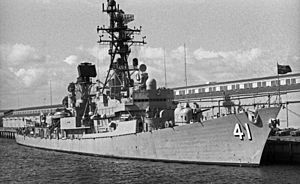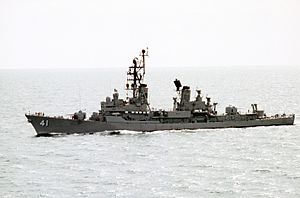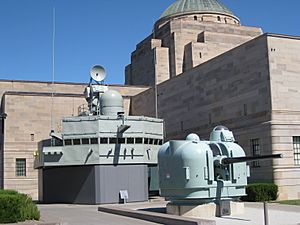HMAS Brisbane (D 41) facts for kids
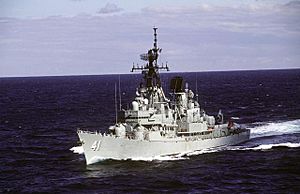
HMAS Brisbane in 1995
|
|
Quick facts for kids History |
|
|---|---|
| Namesake | City of Brisbane |
| Builder | Defoe Shipbuilding Company |
| Laid down | 15 February 1965 |
| Launched | 5 May 1966 |
| Commissioned | 16 December 1967 |
| Decommissioned | 19 October 2001 |
| Motto | "We Aim At Higher Things" |
| Nickname(s) |
|
| Honours and awards |
|
| Fate | Sunk as dive wreck |
| Badge | 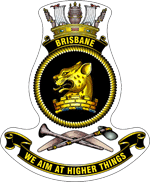 |
| General characteristics | |
| Class and type | Perth-class guided missile destroyer |
| Displacement |
|
| Length |
|
| Beam | 47 ft 1 in (14.35 m) |
| Draught | 15 ft 3 in (4.65 m) maximum |
| Propulsion | 2 × General Electric steam turbines, 70,000 shp (52,000 kW), 2 shafts |
| Speed | 35 knots (65 km/h; 40 mph) |
| Range | 6,000 nautical miles (11,000 km; 6,900 mi) at 15 knots (28 km/h; 17 mph) |
| Complement | 24 officers, 312 sailors |
| Armament |
|
HMAS Brisbane (D 41) was a powerful warship that served in the Royal Australian Navy (RAN). She was one of three ships in the Perth-class, known as guided missile destroyers. Built in the United States, Brisbane was launched in 1966 and joined the RAN in 1967. She was named after the city of Brisbane, Queensland.
During her time in service, Brisbane played important roles in several major events. She was sent to the Vietnam War twice. She also helped with disaster relief after Cyclone Tracy hit Darwin. Later, she was part of the naval forces during the first Gulf War. Brisbane was taken out of service in 2001. In 2005, she was purposely sunk off the coast of Queensland to become a popular dive wreck.
Contents
Building a Modern Destroyer
Brisbane was a Perth-class guided missile destroyer. These ships were based on the United States Navy's Charles F. Adams class. Brisbane was built to be fast and strong. She weighed about 3,370 tons when empty and 4,551 tons when fully loaded. The ship was 437 feet (133 m) long and 47 feet 1 inch (14.35 m) wide.
Power and Weapons
Two large General Electric steam turbines powered Brisbane. They gave the ship 70,000 shaft horsepower (52,000 kW), allowing her to reach speeds of 35 knots (65 km/h; 40 mph). The ship needed 24 officers and 312 sailors to operate.
Brisbane had impressive weapons for her time. Her main weapon was a Mark 13 missile launcher. This could fire Tartar missiles, which were later upgraded to Standard missiles. She also had two large 5"/54 calibre Mark 42 guns. For fighting submarines, she carried two Ikara anti-submarine missile launchers. She also had triple torpedo tube sets. Later in her career, the Ikara launchers were removed. Two Phalanx CIWS units were added in 1990. These are fast-firing guns used to shoot down incoming missiles.
Construction and Early Days
Brisbane was built by the Defoe Shipbuilding Company in Bay City, Michigan. Her construction started on 15 February 1965. She was launched on 5 May 1966. The ship was officially handed over to the RAN on 7 December 1967. She was commissioned (meaning she officially joined the navy) nine days later. Building Brisbane cost about A$50 million. Sailors gave her the nicknames Steel Cat and Fighting Forty-One. These names came from her ship's badge and her pennant number, D 41.
After being commissioned, Brisbane spent nine months training in US waters. She then sailed for Australia on 28 September 1968. After visiting Pearl Harbor and Suva, she arrived in her namesake city, Brisbane, on 17 October.
Service History
Vietnam War Deployments
During the 1960s, Australia sent warships to support the United States Navy in the Vietnam War. RAN destroyers like Brisbane had three main jobs:
- Naval Gunfire Support:' They used their large guns to help ground troops, especially the United States Marine Corps. They would fire at enemy areas or directly support soldiers in battle. Brisbanes callsign for this role was "Flamboyant".
- Anti-infiltration Operations: This involved stopping supplies and reinforcements from reaching enemy forces by checking coastal ships.
- Aircraft Carrier Escort: They protected US Navy aircraft carriers that were launching airstrikes.
Australian ships were under the command of the United States Seventh Fleet during these deployments. Australia was the only allied nation to provide naval support to the US Navy in Vietnam.
First Vietnam Tour
Brisbane arrived in Subic on 28 March 1969 for her first Vietnam deployment. She took over from her sister ship, Perth. She started her duties providing naval gunfire support on 15 April. On 5 May, she was sent to the Gulf of Thailand to help South Vietnamese forces.
On 29 June, while sailing to Singapore for maintenance, Brisbane found a merchant ship, MV Sincere, on fire. After trying to put out the fire without success, Brisbane rescued the crew. She stayed with the burning ship until a salvage vessel arrived.
On 22 July, during a shore bombardment, one of Brisbanes forward guns had an accident. The barrel was damaged, and one sailor was injured. The damaged gun turret had to be removed. Brisbane continued her deployment with only one working gun until a replacement turret arrived in September. She spent some time escorting aircraft carriers like USS Oriskany. Brisbanes first tour ended on 1 October 1969. She returned to Sydney for a major refit that lasted until July 1970.
Second Vietnam Tour
Brisbane began her second Vietnam deployment on 29 March 1971. She was assigned to gunfire support duties. On 15 May, Brisbane's commanding officer was put in charge of all gunfire operations in the area. This was the only time an Australian officer held this position.
During this tour, Brisbane also escorted the aircraft carrier USS Kitty Hawk. On 3 and 4 May, she was briefly detached to help with the return of prisoners-of-war to North Vietnam. However, the operation did not go as planned because most prisoners did not want to return.
From 15 August, Brisbane was very busy with gunfire support missions. She fired many shells, causing her gun barrels to wear out quickly. Other US Navy ships were sent to help, so Brisbane only fired if targets were out of their range. Her second Vietnam deployment finished on 5 September 1971.
In 1971, the Australian government decided to pull all forces out of Vietnam. Brisbane was the last Australian ship to serve in combat there. For her service, Brisbane received the battle honour "Vietnam 1969–71".
1970s and 1980s Operations
On 11 March 1974, Brisbane began a major refit that finished in October. On 24–25 December 1974, Cyclone Tracy devastated Darwin. Brisbanes crew was called back from leave. She sailed on 26 December with HMAS Melbourne, which carried relief supplies. Brisbane arrived first on 31 December. She helped set up communications for the relief effort. Brisbanes role in Operation Navy Help Darwin was the longest of any RAN ship. Her crew helped clear sites, salvage equipment, repair buildings, and install power generators. She finally left Darwin on 31 January 1975.
In 1977, Brisbane took part in RIMPAC, a large international naval exercise. In April 1977, she escorted Melbourne to the United Kingdom for the Silver Jubilee Naval Review. On 9 May, one of Melbourne's helicopters had to land in the ocean. Brisbane successfully rescued the crew. She returned to Sydney on 4 October and began another long refit. This refit lasted until May 1979. During this time, her propulsion system was changed from fuel oil to diesel.
Throughout the early 1980s, Brisbane continued to participate in RIMPAC exercises. She also patrolled the Indian Ocean. She underwent two more refits, one from 1982 to 1983 and another from 1985 to 1987. In 1988, she visited Melbourne and her namesake city, Brisbane. In October, she deployed to South-east Asia for three months. In 1989, she visited New Zealand, Vanuatu, and the Solomon Islands. In 1990, Brisbane attended RIMPAC again. She then prepared for deployment to the Persian Gulf as part of Operation Damask.
Operation Damask in the Gulf War
Brisbane arrived in the Persian Gulf on 6 December 1990. She was part of a naval blockade. From 17 January to 28 February 1991, she was attached to a United States Navy battle group. In late March, she sailed back to Australia. For her actions during Operation Damask, Brisbane received the Meritorious Unit Citation from the Australian government. She also earned a second battle honour, "Kuwait 1990–91".
Later Years and Decommissioning
In the early 1990s, Brisbane operated in South-east Asia. She spent most of 1993 exercising along Australia's east coast. She then had another refit from August 1993 to May 1994. Between 1994 and 1996, and again in 1998, she deployed to South-east Asia for exercises and port visits.
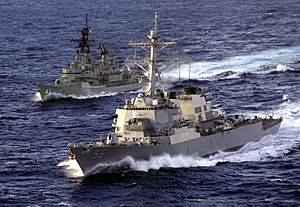
In August 1999, Brisbane took part in Exercise Kakadu. During this exercise, a small fire broke out in her forward gun turret, but it was quickly put out. In March 2000, Brisbane joined two other RAN ships for a Royal New Zealand Navy exercise.
End of Service and Dive Wreck
Brisbane was officially taken out of service on 19 October 2001. There were ideas to donate her to the Australian National Maritime Museum. However, it was decided that Brisbane would be sunk to create a dive wreck off the coast of Queensland.
Before she was sunk, her bridge and one of her 5-inch (127 mm) guns were removed. These parts are now preserved at the Australian War Memorial in Canberra. They are part of the post-1945 galleries, which opened in 2007. Her air search radar was given to the Royal Thai Navy in 2002.
Brisbane was sunk on 31 July 2005. She lies about 2.8 nautical miles (5.2 km; 3.2 mi) off the coast of Mudjimba, Sunshine Coast, Queensland, in 27 metres (89 ft) of water. To sink her, she was filled with 200 to 250 tonnes (200 to 250 long tons; 220 to 280 short tons) of concrete. Then, 38 small charges were set off to make holes in her hull. Brisbane sank in just two minutes and ten seconds. She now rests on the seabed, facing the ocean currents. The highest part of the ship is about 3 metres (9.8 ft) below the surface.
The wreck of Brisbane has become a thriving underwater habitat. It is now home to sponges, soft corals, and hard corals. More than 200 different types of fish have been seen around the wreck. In 2009, a study showed that the wreck had brought A$18 million to the Sunshine Coast economy. This is because many divers visit the site. In July 2010, the Queensland State Government had to increase patrols because people were illegally fishing in the dive exclusion zone. To celebrate the tenth anniversary of her sinking, a radio station did the world's first live underwater radio broadcast from the wreck on 31 July 2015.


